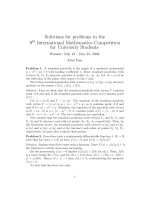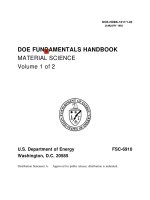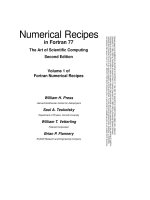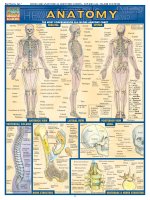modern electrochemistry 2ed 2002 vol 1 ionics - bockris, reddy & amulya
Bạn đang xem bản rút gọn của tài liệu. Xem và tải ngay bản đầy đủ của tài liệu tại đây (26.64 MB, 825 trang )
VOLUME 1
MODERN
ELECTROCHEMISTRY
SECOND EDITION
Ionics
7KLVSDJHLQWHQWLRQDOO\OHIWEODQN
VOLUME 1
MODERN
ELECTROCHEMISTRY
SECOND EDITION
Ionics
John O’M. Bockris
Distinguished Professor of Chemistry
Texas A&M University
College Station, Texas
and
Amulya K. N. Reddy
President
International Energy Initiative
Bangalore, India
KLUWER ACADEMIC PUBLISHERS
NEW YORK, BOSTON, DORDRECHT, LONDON, MOSCOW
eBook ISBN: 0-306-46909-X
Print ISBN: 0-306-45554-4
©2002 Kluwer Academic Publishers
New York, Boston, Dordrecht, London, Moscow
Print ©1998 Kluwer Academic/Plenum Publishers
All rights reserved
No part of this eBook may be reproduced or transmitted in any form or by any means, electronic,
mechanical, recording, or otherwise, without written consent from the Publisher
Created in the United States of America
Visit Kluwer Online at:
and Kluwer's eBookstore at:
New York
To P. Debye and E. Hückel
7KLVSDJHLQWHQWLRQDOO\OHIWEODQN
PREFACE TO THE FIRST EDITION
This book had its nucleus in some lectures given by one of us (J.O’M.B.) in a course
on electrochemistry to students of energy conversion at the University of Pennsylva-
nia. It was there that he met a number of people trained in chemistry, physics, biology,
metallurgy, and materials science, all of whom wanted to know something about
electrochemistry. The concept of writing a book about electrochemistry which could
be understood by people with very varied backgrounds was thereby engendered. The
lectures were recorded and written up by Dr. Klaus Muller as a 293-page manuscript.
At a later stage, A.K.N.R. joined the effort; it was decided to make a fresh start and to
write a much more comprehensive text.
Of methods for direct energy conversion, the electrochemical one is the most
advanced and seems the most likely to become of considerable practical importance.
Thus, conversion to electrochemically powered transportation systems appears to be
an important step by means of which the difficulties of air pollution and the effects of
an increasing concentration in the atmosphere of carbon dioxide may be met. Corro-
sion is recognized as having an electrochemical basis. The synthesis of nylon now
contains an important electrochemical stage. Some central biological mechanisms
have been shown to take place by means of electrochemical reactions. A number of
American organizations have recently recommended greatly increased activity in
training and research in electrochemistry at universities in the United States. Three
new international journals of fundamental electrochemical research were established
between 1955 and 1965.
In contrast to this, physical chemists in U.S. universities seem—perhaps partly
because of the absence of a modern textbook in English—out of touch with the
revolution in fundamental interfacial electrochemistry which has occurred since 1950.
The fragments of electrochemistry which are taught in many U.S. universities belong
not to the space age of electrochemically powered vehicles, but to the age of thermo-
vii
viii
PREFACE TO THE FIRST EDITION
dynamics and the horseless carriage; they often consist of Nernst’s theory of galvanic
cells (1891) together with the theory of Debye and Hückel (1923).
Electrochemistry at present needs several kinds of books. For example, it needs
a textbook in which the whole field is discussed at a strong theoretical level. The most
pressing need, however, is for a book which outlines the field at a level which can be
understood by people entering it from different disciplines who have no previous
background in the field but who wish to use modern electrochemical concepts and
ideas as a basis for their own work. It is this need which the authors have tried to meet.
The book’s aims determine its priorities. In order, these are:
1. Lucidity. The authors have found students who understand advanced courses
in quantum mechanics but find difficulty in comprehending a field at whose center
lies the quantum mechanics of electron transitions across interfaces. The difficulty is
associated, perhaps, with the interdisciplinary character of the material: a background
knowledge of physical chemistry is not enough. Material has therefore sometimes been
presented in several ways and occasionally the same explanations are repeated in
different parts of the book. The language has been made informal and highly expla-
natory. It retains, sometimes, the lecture style. In this respect, the authors have been
influenced by The Feynman Lectures on Physics.
2. Honesty. The authors have suffered much themselves from books in which
proofs and presentations are not complete. An attempt has been made to include most
of the necessary material. Appendices have been often used for the presentation of
mathematical derivations which would obtrude too much in the text.
3. Modernity. There developed during the 1950s a great change in emphasis in
electrochemistry away from a subject which dealt largely with solutions to one in
which the treatment at a molecular level of charge transfer across interfaces dominates.
This is the “new electrochemistry,” the essentials of which, at an elementary level, the
authors have tried to present.
4. Sharp variation is standard. The objective of the authors has been to begin each
chapter at a very simple level and to increase the level to one which allows a connecting
up to the standard of the specialized monograph. The standard at which subjects are
presented has been intentionally variable, depending particularly on the degree to
which knowledge of the material appears to be widespread.
5. One theory per phenomenon. The authors intend a teaching book
,
which acts
as an introduction to graduate studies. They have tried to present, with due admission
of the existing imperfections, a simple version of that model which seemed to them at
the time of writing to reproduce the facts most consistently. They have for the most
part refrained from presenting the detailed pros and cons of competing models in areas
in which the theory is still quite mobile.
In respect to references and further reading: no detailed references to the literature
have been presented, in view of the elementary character of the book’s contents, and
the corresponding fact that it is an introductory book, largely for beginners. In the
PREFACE TO THE FIRST EDITION ix
“further reading” lists, the policy is to cite papers which are classics in the development
of the subject, together with papers of particular interest concerning recent develop-
ments, and in particular, reviews of the last few years.
It is hoped that this book will not only be useful to those who wish to work with
modern electrochemical ideas in chemistry, physics, biology, materials science, etc.,
but also to those who wish to begin research on electron transfer at interfaces and
associated topics.
The book was written mainly at the Electrochemistry Laboratory in the University
of Pennsylvania, and partly at the Indian Institute of Science in Bangalore. Students
in the Electrochemistry Laboratory at the University of Pennsylvania were kind
enough to give guidance frequently on how they reacted to the clarity of sections
written in various experimental styles and approaches. For the last four years, the
evolving versions of sections of the book have been used as a partial basis for
undergraduate, and some graduate, lectures in electrochemistry in the Chemistry
Department of the University.
The authors’ acknowledgment and thanks must go first to Mr. Ernst Cohn of the
National Aeronautics and Space Administration. Without his frequent stimulation,
including very frank expressions of criticism, the book might well never have emerged
from the Electrochemistry Laboratory.
Thereafter, thanks must go to Professor B. E. Conway, University of Ottawa, who
gave several weeks of his time to making a detailed review of the material. Plentiful
help in editing chapters and effecting revisions designed by the authors was given by
the following: Chapters IV and V, Dr. H. Wroblowa (Pennsylvania); Chapter VI, Dr.
C. Solomons (Pennsylvania) and Dr. T. Emi (Hokkaido); Chapter VII, Dr. E. Gileadi
(Tel-Aviv); Chapters VIII and IX, Prof. A. Despic (Belgrade), Dr. H. Wroblowa, and
Mr. J. Diggle (Pennsylvania); Chapter X, Mr. J. Diggle; Chapter XI, Dr. D. Cipris
(Pennsylvania). Dr. H. Wroblowa has to be particularly thanked for essential contributions
to the composition of the Appendix on the measurement of Volta potential differences.
Constructive reactions to the text were given by Messers. G. Razumney, B. Rubin,
and G. Stoner of the Electrochemistry Laboratory. Advice was often sought and
accepted from Dr. B. Chandrasekaran (Pennsylvania), Dr. S. Srinivasan (New York),
and Mr. R. Rangarajan (Bangalore).
Comments on late drafts of chapters were made by a number of the authors’
colleagues, particularly Dr. W. McCoy (Office of Saline Water), Chapter II; Prof. R.
M. Fuoss (Yale), Chapter III; Prof. R. Stokes (Armidale), Chapter IV; Dr. R. Parsons
(Bristol), Chapter VII; Prof. A. N. Frumkin (Moscow), Chapter VIII; Dr. H. Wrob-
lowa, Chapter X; Prof. R. Staehle (Ohio State), Chapter XI. One of the authors
(A.K.N.R.) wishes to acknowledge his gratitude to the authorities of the Council of
Scientific and Industrial Research, India, and the Indian Institute of Science, Banga-
lore, India, for various facilities, not the least of which were extended leaves of
absence. He wishes also to thank his wife and children for sacrificing many precious
hours which rightfully belonged to them.
7KLVSDJHLQWHQWLRQDOO\OHIWEODQN
PREFACE
The textbook Modern Electrochemistry by Bockris and Reddy originated in the needs
of students at the Energy Conversion Institute of the University of Pennsylvania in the
late 1960s. People trained in various disciplines from mathematics to biology wanted
to understand the new high-energy-density storage batteries and the doubling of the
efficiency of energy conversion offered by fuel cells over heat engines. The task was
to take a group that seemed to be above average in initiative and present electrochem-
istry well enough to meet their needs.
The book turned out to be a great success. Its most marked characteristic
was—is—lucidity. The method used was to start off at low level and then move up in
a series of very small steps. Repetition is part of the technique and does not offend,
for the lesson given each time is the same but is taught differently.
The use of the book spread rapidly beyond the confines of energy conversion
groups. It led to the recognition of physical electrochemistry—the electrochemical
discipline seen from its roots in physics and physical chemistry, and not as a path to
superior chemical analysis. The book outlined electrochemical science for the first
time in a molecular way, paying due heed to thermodynamics as bedrock but keeping
it as background. The success of the effort has been measured not only by the total
sales but by the fact that another reprinting had to be made in 1995, 25 years after the
first one. The average sales rate of the first edition is even now a dozen copies a month!
Given this background, the challenge of writing a revised edition has been a
memorable one. The changes in the state of electrochemical science in the quarter
century of the book’s life have been broad and deep. Techniques such as scanning
tunneling microscopy enable us to see atoms on electrodes. Computers have allowed
a widespread development of molecular dynamics (MD) calculations and changed the
balance between informed guesses and the timely adjustment of parameters in force
laws to enable MD calculations to lead to experimental values. The long-postponed
introduction of commercial electric cars in the United States has been realized and is
xi
xii PREFACE
the beginning of a great step toward a healthier environment. The use of the new
room-temperature molten salts has made it possible to exploit the advantage of
working with pure liquid electrolytes—no solvent—without the rigors of working at
1000
°C.
All the great challenges of electrochemistry at 2000 A.D. do not have to be
addressed in this second edition for this is an undergraduate text, stressing the teaching
of fundamentals with an occasional preview of the advancing frontier.
The basic attributes of the book are unchanged: lucidity comes first. Since the text
is not a graduate text, there is no confusing balancing of the merits of one model against
those of another; the most probable model at the time of writing is described.
Throughout it is recognized that theoretical concepts rise and fall; a theory that lasts
a generation is doing well.
These philosophies have been the source of some of the choices made when
balancing what should be retained and what rewritten. The result is quite heterogene-
ous. Chapters 1 and 2 are completely new. The contributions from neutron diffraction
measurements in solutions and those from other spectroscopic methods have torn away
many of the veils covering knowledge of the first 1–2 layers of solvent around an ion.
Chapter 3 also contains much new material. Debye and Huckel’s famous calculation
is two generations old and it is surely time to move toward new ideas. Chapter 4, on
the other hand, presents much material on transport that is phenomenological—mate-
rial so basic that it must be presented but shows little variation with time.
The last chapter, which is on ionic liquids, describes the continuing evolution that
is the result of the development of low-temperature molten salts and the contributions
of computer modeling. The description of models of molten silicates contains much
of the original material in the first edition, for the models described there are those still
used today.
A new feature is the liberal supply of problems for student solution—about 50
per chapter. This idea has been purloined from the excellent physical chemistry
textbook by Peter Atkins (W. H. Freeman). There are exercises, practice in the use of
the chapter’s equations; problems (the chapter’s material related to actual situations);
and finally, a few much more difficult tasks which are called “microresearch prob-
lems,” each one of which may take some hours to solve.
The authors have not hesitated to call on colleagues for help in understanding new
material and in deciding what is vital and what can be left for the literature. The authors
would particularly like to thank John Enderby (University of Bristol) for his review
of Chapter 2; Tony Haymet (University of Sydney) for advice on the weight to be
given to various developments that followed Debye and Hückel’s ground-breaking
work and for tutoring us on computational advances in respect to electrolytic ion pairs.
Michael Lyons (University of Dublin) is to be thanked for allowing the present authors
use of an advanced chapter on transport phenomena in electrolytes written by him.
Austin Angell (Arizona State University of Tempe) in particular and Douglas Inman
PREFACE xiii
(Imperial College) have both contributed by means of criticisms (not always heeded)
in respect to the way to present the material on structure in pure electrolytes.
Many other electrochemists have helped by replying to written inquiries.
Dr. Maria Gamboa is to be thanked for extensive editorial work, Ms. Diane
Dowdell for her help with information retrieval, and Mrs. Janie Leighman for her
excellence in typing the many drafts.
Finally, the authors wish to thank Ms. Amelia McNamara and Mr. Ken Howell
of Plenum Publishing for their advice, encouragement, and patience.
7KLVSDJHLQWHQWLRQDOO\OHIWEODQN
ACKNOWLEDGMENTS
In writing a book of this type, the authors have accessed the advice of many colleagues,
often by telephone discussions and sometimes in written exchanges.
A few individuals, however, deserve mention for having done much more than
normal collegial cooperation implies.
Thus, the chapter on solvation was greatly helped by consultation and correspon-
dence with Professor J. E. Enderby (University of Bristol).
In respect to Chapter 3, advice was sought from and given by Professor Harold
Friedman (University of New York at Stony Brook) and Professor J. C. Rasaiah
(University of Maine).
Professor Antony Haymet (University of Sydney, Australia) was particularly
helpful in the giving of his latest work, sometimes unpublished, and the giving of
advice, both in writing and in telephone discussions.
Chapter 4 is rewritten to a lesser degree than the other chapters but the new
material has been discussed with Professor B. E. Conway (University of Ottawa).
Chapter 5 was greatly improved by discussions and several letter exchanges with
Professor Austin Angel (Arizona State University at Tempe) and to some extent with
Professor Douglas Inman (Imperial College of Science and Technology, London
University).
xv
7KLVSDJHLQWHQWLRQDOO\OHIWEODQN
CONTENTS
Nomenclature xxxiii
CHAPTER 1
ELECTROCHEMISTRY
1.1.
1.2.
1.3.
1.4.
1.4.1.
1.4.2.
1.4.3.
1.5.
1.5.1.
1.5.2.
1.5.3.
1.6.
A State of Excitement
Two Kinds of Electrochemistry
Some Characteristics of Electrodics
Properties of Materials and Surfaces . . . . . . . . . . . .
Interfaces in Contact with Solutions Are Always Charged
The Continuous Flow of Electrons across an Interface: Electrochemical
Reactions
Electrochemical and Chemical Reactions
The Relation of Electrochemistry to Other Sciences
Some Diagrammatic Presentations
Some Examples of the Involvement of Electrochemistry in Other Sciences
1
3
5
6
6
8
9
12
12
13
13
13
15
15
15
15
16
1.5.2.1.
1.5.2.2.
1.5.2.3.
1.5.2.4.
1.5.2.5.
Chemistry.
Metallurgy.
Engineering.
Biology.
Geology.
Electrochemistry as an Interdisciplinary Field, Distinct from Chemistry
The Frontier in Ionics: Nonaqueous Solutions
xvii
xviii CONTENTS
1.7.
1.8.
1.9.
1.10.
1.11.
1.12.
1.12.1.
1.12.2.
A New World of Rich Variety: Room-Temperature Molten Salts .
Electrochemical Determination of Radical Intermediates by Means
of Infrared Spectroscopy
Relay Stations Placed Inside Proteins Can Carry an Electric Current
Speculative Electrochemical Approach to Understanding
Metabolism
The
Electrochemistry
of
Cleaner Environments
Science, Technology, Electrochemistry,
and
Time
Significance of
Interfacial
Charge-Transfer Reactions
The Relation between Three Major Advances in Science, and the Place of
Electrochemistry in the Developing World
Further Reading
19
20
22
24
25
27
27
28
32
CHAPTER 2
ION–SOLVENT INTERACTIONS
2.1.
2.2.
2.3.
2.3.1.
2.3.2.
2.3.3.
2.4.
2.4.1.
2.4.2.
2.4.3.
2.5.
2.5.1.
2.5.2.
2.5.3.
2.6.
2.6.1.
Introduction
Breadth of Solvation as a Field
A Look at Some Approaches to Solvation Developed Mainly after
1980
Statistical Mechanical Approaches
What Are Monte Carlo and Molecular Dynamics Calculations?
Spectroscopic Approaches
Structure
of the
Most Common Solvent, Water
How Does the Presence of an Ion Affect the Structure of Neighboring
Water?
Size and Dipole Moment of Water Molecules in Solution
TheIon–DipoleModel for Ion–SolventInteractions
Further Reading
Tools for Investigating Solvation
Introduction
Thermodynamic Approaches: Heats of Solvation
Obtaining Experimental Values of Free Energies and Entropies of the
Solvation of Salts
Partial Molar Volumes of Ions in Solution
Definition
35
37
39
39
39
40
41
46
48
49
50
50
50
51
53
55
55
CONTENTS xix
2.6.2.
2.6.3.
2.7.
2.7.1.
2.7.2.
2.8.
2.8.1.
2.9.
2.9.1.
2.10.
2.10.1.
2.11.
2.11.1.
2.11.2.
2.11.3.
2.11.4.
2.11.5.
2.11.6.
2.12.
2.12.1.
2.12.2.
2.12.3.
2.13.
2.14.
2.14.1.
2.14.2.
2.15.
2.15.1.
2.15.2.
How Does One Obtain Individual Ionic Volume from the Partial Molar
Volume of Electrolytes?
Conway’s Successful Extrapolation
Compressibility and Vibration Potential Approach to Solvation
Numbers of Electrolytes
Relation of Compressibility to Solvation
Measuring Compressibility: How It Is Done
Total
Solvation
Numbers
of
Ions
in
Electrolytes
Ionic Vibration Potentials: Their Use in Obtaining the Difference of the
Solvation Numbers of Two Ions in a Salt
Solvation Numbers at High Concentrations
Hydration Numbers
from
Activity Coefficients
Transport
The Mobility Method
Spectroscopic Approaches to Obtaining Information on Structures
near an Ion
General
IR Spectra
The
Neutron
Diffraction
Approach
to
Solvation
To What Extent Do Raman Spectra Contribute to Knowledge of the
Solvation Shell?
Raman Spectra and Solution Structure
Information on Solvation from Spectra Arising from Resonance in the
Nucleus
Further Reading
Dielectric Effects
Dielectric Constant of Solutions
How Does One Measure the Dielectric Constant of Ionic Solutions? . . .
Conclusion. . .
Further Reading
Ionic Hydration in the Gas Phase
Individual Ionic
Properties
Introduction
A General Approach to Individual Ionic Properties: Extrapolation to Make
the Effects of One Ion Negligible
Individual
Heat
of
Hydration
of the
Proton
Introduction.
Relative Heats
of
Solvation
of
Ions
in the
Hydrogen Scale
56
57
58
58
60
61
63
68
68
70
70
72
72
73
77
83
84
85
86
87
87
92
93
93
94
98
98
99
99
99
100
xx CONTENTS
2.15.3.
2.15.4.
2.15.5.
2.15.6.
2.15.7.
2.15.8.
2.15.9.
2.15.10.
2.15.11.
2.15.12.
2.15.13.
2.15.14.
2.15.15.
2.16.
2.16.1.
2.16.2.
2.16.3.
2.16.4.
2.17.
2.17.1.
2.17.2.
2.17.3.
2.17.4.
Do Oppositely Charged Ions of Equal Radii Have Equal Heats of
Solvation?
The Water Molecule as an Electrical Quadrupole
The Ion–Quadrupole Model of Ion–Solvent Interactions
Ion-Induced Dipole Interactions in the Primary Solvation Sheath
How Good Is the Ion–Quadrupole Theory of Solvation?
How Can Temperature Coefficients of Reversible Cells Be Used to
Obtain Ionic Entropies?
Individual Ionic Properties: A Summary
Model Calculations of Hydration Heats
Heat Changes Accompanying
Hydration
2.15.11.1.
2.15.11.2.
2.15.11.3.
2.15.11.4.
2.15.11.5.
2.15.11.6.
2.15.11.7.
2.15.11.8.
2.15.11.9.
(Model A)
(Model B)
(Model C)
Numerical Evaluation of
Entropy of Hydration: Some Possible Models
Entropy Changes Accompanying Hydration
2.15.13.1.
2.15.13.2.
2.15.13.3.
2.15.13.4.
2.15.13.5.
2.15.13.6.
2.15.13.7.
(Model A)
(Model C)
Is There a Connection between the Entropy of Solvation and the Heats of
Hydration?
Krestov’s Separation of Ion and Solvent Effects in Ion Hydration
More on Solvation Numbers
Introduction
Dynamic Properties of Water and Their Effect on Hydration Numbers . .
A Reconsideration of the Methods for Determining the Primary
Hydration Numbers Presented in Section 2.15
Why Do Hydration Heats of Transition-Metal Ions Vary Irregularly with
Atomic Number?
Further Reading
Computer-Simulation Approaches to Ionic Solvation
General
An Early Molecular Dynamics Attempt at Calculating Solvation Number
Computational Approaches to Ionic Solvation
Basic Equations Used in Molecular Dynamics Calculations
101
102
103
106
107
110
114
114
117
119
120
121
121
121
122
122
124
124
126
126
127
127
127
130
132
133
134
138
139
139
139
141
142
145
152
153
153
154
154
155
CONTENTS xxi
2.18.
2.19.
2.20.
2.20.1.
2.20.2.
2.20.3.
2.20.4.
2.20.5.
2.20.6.
2.21.
2.21.1.
2.21.2.
2.22.
2.22.1.
2.22.2.
2.22.3.
2.22.4.
2.22.5.
2.23.
2.23.1.
2.23.2.
2.23.3.
2.23.4.
2.24.
2.24.1.
2.24.2.
2.24.3.
2.24.4.
2.24.5.
2.25.
2.25.1.
2.25.2.
2.25.3.
Computation
of
Ion–Water
Clusters
in the Gas
Phase
Solvent
Dynamic
Simulations
for
Aqueous
Solutions
Further Reading .
Interactions
of
Ions
with
Nonelectrolytes
in
Solution
The Problem
Change in Solubility of a Nonelectrolyte Due to Primary Solvation
Change in Solubility Due to Secondary Solvation
Net Effect on Solubility of Influences from Primary and Secondary
Solvation .
Cause of Anomalous Salting In
Hydrophobic Effect in Solvation
Further Reading
Dielectric Breakdown of Water
Phenomenology
Mechanistic Thoughts
Electrostriction
Electrostrictive Pressure near an Ion in Solution
Maximum Electrostrictive Decrease in the Volume of Water in the First
Hydration Shell
Dependence of Compressibility on Pressure
Volume Change and Where It Occurs in Electrostriction
Electrostriction in Other Systems
Further Reading
Hydration of Polyions
Introduction
Volume of Individual Polyions
Hydration of Cross-Linked Polymers (e.g., Polystyrene Sulfonate) . . .
Effect of Macroions on the Solvent
Hydration in Biophysics .
A
Model
for
Hydration
and
Diffusion
of
Polyions
Molecular Dynamics Approach to Protein Hydration
Protein Dynamics as a Function of Hydration
Dielectric Behavior of DNA
Solvation
Effects
and the
Transition
Water in Biological Systems . .
Does Water in Biological Systems Have a Different Structure from Water
In Vitro?
Spectroscopic Studies
of
Hydration
of
Biological Systems
Molecular Dynamic Simulations of Biowater
157
163
166
166
166
167
168
171
173
175
178
179
179
181
185
185
187
187
189
190
190
190
190
191
191
192
192
193
194
194
195
197
197
197
198
198
xxii CONTENTS
2.26.
2.27.
2.27.1.
2.27.2.
2.27.3.
2.27.4.
Some Directions of Future Research in Ion–Solvent
Interactions
Overview of Ionic Solvation and Its Functions
Hydration of Simple Cations and Anions
Transition-Metal Ions
Molecular Dynamic Simulations
Functions of Hydration
Appendix 2.1. The Born Equation
Appendix
2.2.
Interaction
between
an Ion and a
Dipole
Appendix 2.3. Interaction between an Ion and a Water Quadrupole
CHAPTER 3
ION–ION INTERACTIONS
3.1.
3.2.
3.2.1.
3.2.2.
3.2.3.
3.2.4.
3.3.
3.3.1.
3.3.2.
3.3.3.
3.3.4.
3.3.5.
3.3.6.
3.3.7.
3.3.8.
3.3.9.
3.3.10.
3.4.
3.4.1.
Introduction
True and Potential Electrolytes
Ionic Crystals Form True Electrolytes
Potential Electrolytes: Nonionic Substances That React with the Solvent to
Yield Ions
An Obsolete Classification: Strong and Weak Electrolytes
The Nature of the Electrolyte and the Relevance of Ion–Ion Interactions .
The Debye–Hückel (or Ion-Cloud) Theory of Ion–Ion Interactions
A Strategy for a Quantitative Understanding of Ion–Ion Interactions . . .
A Prelude to the Ionic-Cloud Theory
Charge Density near the Central Ion Is Determined by Electrostatics:
Poisson’s Equation
Excess Charge Density near the Central Ion Is Given by a Classical Law
for the
Distribution
of
Point Charges
in a
Coulombic Field
A Vital Step in the Debye–Hückel Theory of the Charge Distribution
around Ions: Linearization of the Boltzmann Equation
The Linearized Poisson–Boltzmann Equation
Solution of the Linearized P–B Equation
The Ionic Cloud around a Central Ion
Contribution of the Ionic Cloud to the Electrostatic Potential at a Distance
r
from
the
Central
Ion
The Ionic Cloud and the Chemical-Potential Change Arising from Ion-Ion
Interactions
Activity Coefficients and Ion–Ion Interactions
Evolution of the Concept of an Activity Coefficient
199
201
201
203
203
203
204
207
209
225
225
225
226
228
229
230
230
232
235
236
237
238
239
242
247
250
251
251
CONTENTS xxiii
3.4.2.
3.4.3.
3.4.4.
3.4.5.
3.4.6.
3.4.7.
3.4.8.
3.5.
3.5.1.
3.5.2.
3.5.3.
3.5.4.
3.5.5.
3.5.6.
3.5.7.
3.6.
3.6.1.
3.6.2.
3.6.3.
3.7.
3.8.
3.8.1.
3.8.2.
3.8.3.
3.8.4.
3.8.5.
3.8.6.
3.9.
3.10.
The Physical Significance of Activity Coefficients
The Activity Coefficient of a Single Ionic Species Cannot Be Measured .
The
Mean Ionic Activity Coefficient
Conversion of Theoretical Activity-Coefficient Expressions into a Testable
Form
Experimental Determination of Activity Coefficients
How to Obtain Solute Activities from Data on Solvent Activities
A Second Method to Obtain Solute Activities: From Data on Concentration
Cells and Transport Numbers
Further Reading
The Triumphs and Limitations of the Debye–Hückel Theory of
Activity Coefficients
How Well Does the Debye–Hückel Theoretical Expression for Activity
Coefficients Predict Experimental Values?
Ions Are of Finite Size, They Are Not Point Charges
The Theoretical Mean Ionic-Activity Coefficient in the Case of Ionic
Clouds with Finite-Sized Ions
The Ion
Size Parameter
a
Comparison of the Finite-Ion-Size Model with Experiment
The Debye–Hückel Theory of Ionic Solutions: An Assessment
Parentage of the Theory of Ion–Ion Interactions
Further Reading
Ion–Solvent
Interactions
and the
Activity
Coefficient
Effect of Water Bound to Ions on the Theory of Deviations from Ideality
Quantitative Theory of the Activity of an Electrolyte as a Function of the
Hydration Number
The Water Removal Theory of Activity Coefficients and Its Apparent
Consistency with Experiment at High Electrolytic Concentrations
The So-called “Rigorous” Solutions of the Poisson–Boltzmann
Equation
Temporary Ion Association in an Electrolytic Solution: Formation
of Pairs, Triplets
Positive and Negative Ions Can Stick Together: Ion-Pair Formation . . .
Probability of Finding Oppositely Charged Ions near Each Other
The Fraction of Ion Pairs, According to Bjerrum
The Ion-Association Constant of Bjerrum
Activity Coefficients, Bjerrum’s Ion Pairs, and Debye’s Free Ions
From Ion Pairs to Triple Ions to Clusters of Ions
The Virial Coefficient Approach to Dealing with Solutions
Further Reading
Computer Simulation in the Theory of Ionic Solutions
253
255
256
257
260
261
263
267
268
268
273
277
280
280
286
292
293
293
293
295
297
300
304
304
304
307
309
314
314
315
318
319
xxiv CONTENTS
3.10.1.
3.10.2.
3.10.3.
3.10.4.
3.11.
3.11.1.
3.11.2.
3.12.
3.13.
3.14.
3.15.
3.15.1
3.15.2
3.15.3
3.15.4
3.16.
The Monte Carlo Approach
Molecular Dynamic Simulations
The Pair-Potential Interaction
Experiments and Monte Carlo and MD Techniques
Further Reading
The
Correlation Function Approach
Introduction
Obtaining
Solution
Properties
from
Correlation
Functions
How Far Has the MSA Gone in the Development of Estimation of
Properties for Electrolyte Solutions?
Computations of Dimer and Trimer Formation in Ionic Solution .
More Detailed Models
Further Reading
Spectroscopic Approaches to th e Constitution of Electrolytic
Solutions
Visible and Ultraviolet Absorption Spectroscopy
Raman Spectroscopy
Infrared Spectroscopy
Nuclear Magnetic Resonance Spectroscopy
Further Reading
Ionic Solution Theory in the Twenty-First Century
Appendix 3.1. Poisson’s Equation for a Spherically
Symmetrical Charge Distribution
Appendix
3.2.
Evaluation
of the
Integral
Appendix 3.3. Derivation of the Result,
Appendix 3.4. To Show That the Minimum in the versus r Curve Occurs
at
Appendix 3.5. Transformation from the Variable r to the Variable
Appendix 3.6. Relation between Calculated and Observed Activity
Coefficients
CHAPTER 4
ION TRANSPORT IN SOLUTIONS
4.1.
4.2.
Introduction
Ionic Drift under a Chemical-Potential Gradient: Diffusion
319
320
321
322
323
324
324
324
326
329
333
336
337
338
339
340
340
341
341
344
345
345
346
. 347
347
361
363









